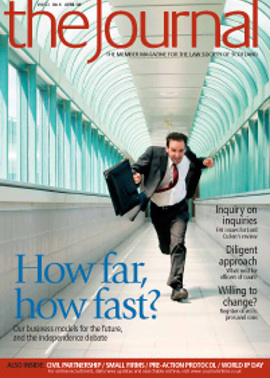Testing insolvency

The English Companies Court has recently been asked to give guidance on the meaning of “inability to pay debts”, and in particular on the meaning of when they fall due: Re Cheyne Finance plc [2007] EWHC 2402 (Ch).
Cheyne Finance plc was a structured investment vehicle heavily invested in mortgage backed securities. After the credit crunch, it ceased trading and went into “run off”. Receivers were appointed. In an earlier application the court held that the proper approach to settling liabilities from maturing assets was a “pay as you go” approach in which the receivers applied monies received by paying first the debts of senior creditors as and when they fell due. A pari passu approach making full provision for payment of all senior debts, in precedence to payment on time and in full of debts as and when they fell due, was rejected.
It then became clear that this approach would require a high level of asset sales before maturity, which would result in sales at a discount, deplete the company’s balance sheet and result in it being unable to pay later maturing debts. The receivers then returned to court with a further application for directions seeking assistance in determining whether there was an “insolvency event” as defined in the common terms agreement.
Future dues
It was clear that the parties had deliberately excluded the balance sheet test of insolvency in s 123(2) of the Insolvency Act 1986, by which a company is deemed unable to pay its debts if it is proved that the value of its assets is less than the amount of its liabilities, taking into account its contingent and prospective liabilities. The questions then focused on
s 123(1)(e), which states that a company is deemed unable to pay its debts if it is proved that it is unable to pay its debts “as they fall due”. Following argument presented by inter alia a number of the senior creditors, the questions for decision resolved into two related issues, namely (1) to what extent was it permissible for the receivers to have regard to senior debts falling due in the future, in addressing the company’s commercial solvency; and (2) with what degree of confidence must the receivers have formed a view that the company was or was about to become unable to pay its debts as they fell due before they could properly make an insolvency event determination.
The court held that future debts as well as those debts presently due were relevant. The words “as they fall due” were regarded as words of futurity, and it was common sense not to ignore future debts. The changes made in the 1985 Insolvency Act and now incorporated in s 123 had split out for the first time commercial and balance sheet insolvency. In place of the mandatory requirement to take into account contingent and prospective liabilities (which remained in s 123(2)), the phrase “as they fall due” had been added after “debts”.
Doubtful benefit
At first glance, it might be thought that the decision is helpful, but on reflection that may be false. Default clauses which do not simply adopt
s 123 often seek to expand on the s 123(1)(e) test by adding the words “or is about to become” between the words “is unable”. In Cheyne Finance, the court has effectively held that these words are redundant as the test of whether a company is unable to pay its debts as they fall due already includes a look at all future debts. A similar analogy would be that a condition of administration is that a company “is or is likely to become unable to pay its debts” (1986 Act, sched B1, para 11(a)). Is the statutory drafting redundant? The Cheyne Finance decision may make the interpretation more, rather than less, confusing.
The case also leaves open how far into the future one has to look. The court held that this was a fact-sensitive question – “cash flow or commercial insolvency is not to be ascertained by a slavish focus only on debts due as at the relevant date. Such a blinkered review will, in some cases, fail to see that a momentary inability to pay is only the result of a temporary lack of liquidity soon to be remedied, and in other cases fail to see that due to an endemic shortage of working capital a company is on any commercial view insolvent, even though it may continue to pay its debts for the next few days, weeks or even months before an inevitable failure”.
The judge also rejected the view that a company will always be balance sheet insolvent in circumstances where a review of future debts shows that it is commercially insolvent. The judge gave an example of a company with a very illiquid asset worth in excess of a future debt due in six months. He argued that “on any commercial view” the company could not pay its debts as they fell due, but it is or would be balance sheet solvent. He further held that in the case of a company which is still trading with a high degree of uncertainty as to the profile of future cash flow, a review of the future would often make little difference and the alternative balance sheet test would afford a petitioner for winding up a “convenient alternative means of proof” of a deemed insolvency. In Cheyne, with the company being in run off, its future cash flow profile was “abnormally clear”. One feels that the judge ignored the very commercial possibilities of finance being raised on the basis of assets, and liquidity facilities being made available.
In summary, Cheyne Finance may be a new friend for creditors as, following Cheyne, a reference to s 123(1)(e) may now be breached earlier than parties would have expected before Cheyne and allow creditors to put pressure on debtors. It may assist creditors seeking financial information about a debtor and, rather than clarifying matters, it is hard to avoid the conclusion that Cheyne makes the insolvency test far harder to apply than before, with no clarity on where the line is drawn on the element of futurity, and no clarity on whether the additional words “or is about to become” limit or extend the element of the futurity.
Alistair S Burrow, Head of Recovery, Tods Murray LLP
In this issue
- Thinking ahead
- A line too often crossed
- Big leap forward
- Independence: still viable?
- FAIs: a new lease of life
- ARTL: Turquoise is in the pink
- Summary trials: deciding the facts
- Life at the sharp end
- Conscience and public service
- Wills and ways
- Achieving "senior" rates?
- CPD: the way forward
- Life on the edge
- Pre-action protocol for industrial disease claims
- Fit a doin'?
- Same difference
- Curiosity corner
- System? What system?
- Reviewing appeals
- Testing insolvency
- Scottish Solicitors' Discipline Tribunal
- Website reviews
- Book reviews
- Day of creation
- Lawyer behind the camera
- Homing in on home reports






